The NVIDIA GeForce GTX 970 Review: Featuring EVGA
by Ryan Smith on September 26, 2014 10:00 AM ESTCompute
With GTX 980 NVIDIA surprised us with their stunning turnaround in in GPU compute performance, which saw them capable of reaching the top in many compute benchmarks they couldn’t before. GTX 970 meanwhile should benefit from these architectural and driver improvements, though since compute is nearly analogous to shader performance this is also a case where the performance difference between the GTX 970 and GTX 980 stands to be among its widest.
As always we’ll start with LuxMark2.0, the official benchmark of SmallLuxGPU 2.0. SmallLuxGPU is an OpenCL accelerated ray tracer that is part of the larger LuxRender suite. Ray tracing has become a stronghold for GPUs in recent years as ray tracing maps well to GPU pipelines, allowing artists to render scenes much more quickly than with CPUs alone

Thanks to GTX 980 taking the top spot here, GTX 970 still maintains a small lead over R9 290XU. So even with the GTX 970's weaker performance, it can still manage to outperform AMD's flagship in this case.
For our second set of compute benchmarks we have CompuBench 1.5, the successor to CLBenchmark. We’re not due for a benchmark suite refresh until the end of the year, however as CLBenchmark does not know what to make of GTX 980 and is rather old overall, we’ve upgraded to CompBench 1.5 for this review.
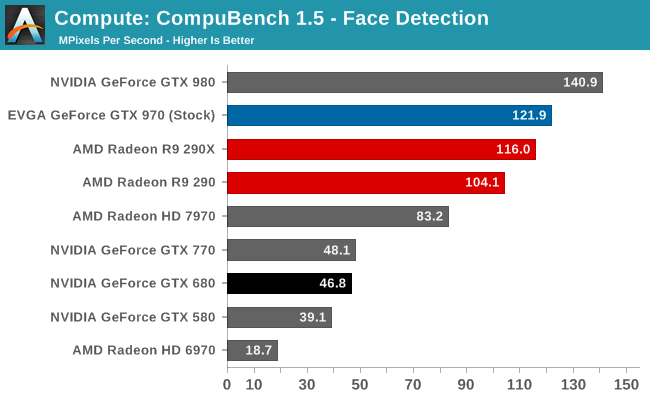
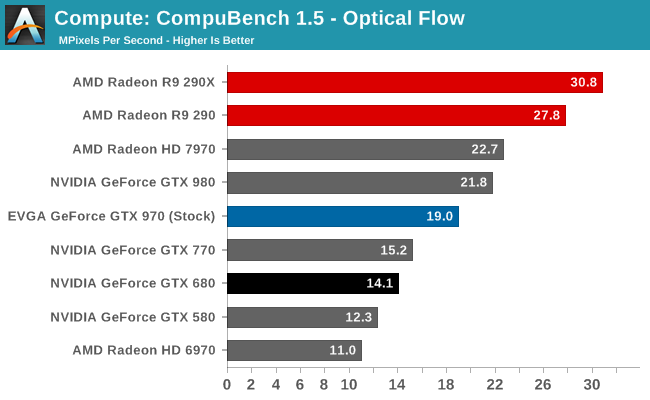
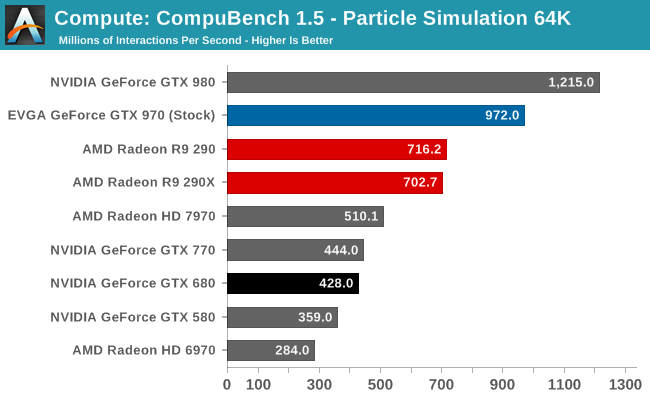
In the cases where the GTX 980 does well, so does the GTX 970. In the cases where the GTX 980 wasn’t fast enough to top the charts, the GTX 970 will be similarly close behind. Overall compared to AMD’s lineup we see the whole gamut, from a tie between the GTX 970 and R9 290XU to victories for either card.
Our 3rd compute benchmark is Sony Vegas Pro 12, an OpenGL and OpenCL video editing and authoring package. Vegas can use GPUs in a few different ways, the primary uses being to accelerate the video effects and compositing process itself, and in the video encoding step. With video encoding being increasingly offloaded to dedicated DSPs these days we’re focusing on the editing and compositing process, rendering to a low CPU overhead format (XDCAM EX). This specific test comes from Sony, and measures how long it takes to render a video.
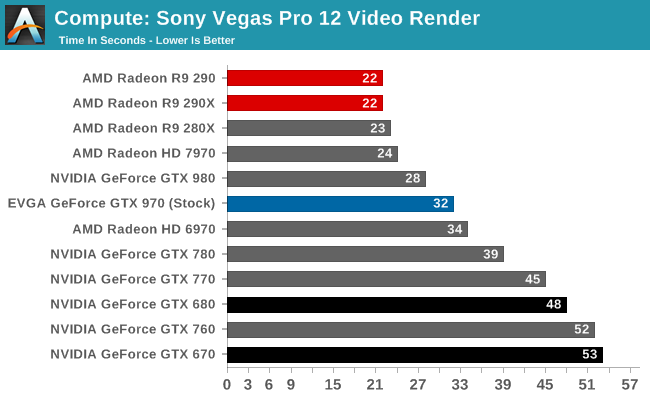
As expected, GTX 970 sheds a bit of performance here. AMD still holds a lead here overall, and against GTX 970 that lead is a little bit larger.
Moving on, our 4th compute benchmark is FAHBench, the official Folding @ Home benchmark. Folding @ Home is the popular Stanford-backed research and distributed computing initiative that has work distributed to millions of volunteer computers over the internet, each of which is responsible for a tiny slice of a protein folding simulation. FAHBench can test both single precision and double precision floating point performance, with single precision being the most useful metric for most consumer cards due to their low double precision performance. Each precision has two modes, explicit and implicit, the difference being whether water atoms are included in the simulation, which adds quite a bit of work and overhead. This is another OpenCL test, utilizing the OpenCL path for FAHCore 17.
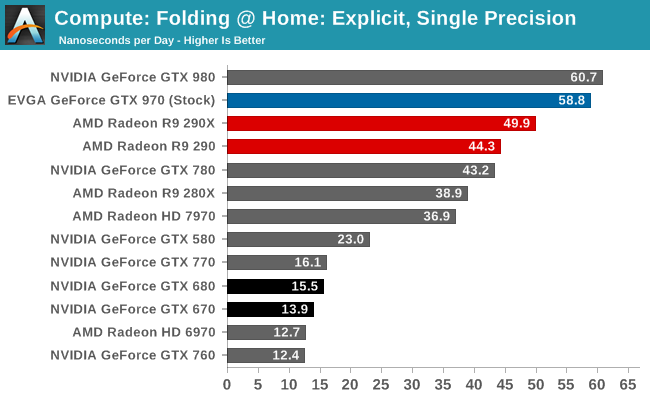
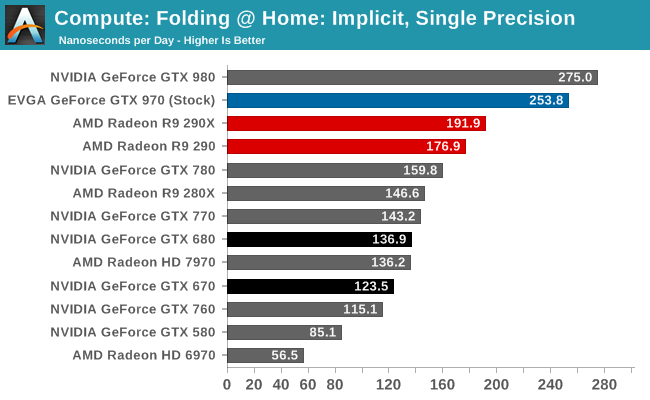
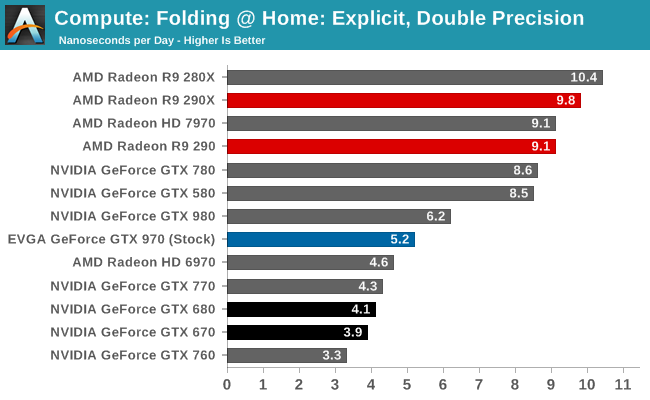
With the GTX 980 holding such a commanding lead here, even with the GTX 970’s lower performance it still is more than enough to easily beat any other card in single precision Folding @ Home workloads. Only in double precision with NVIDIA’s anemic 1:32 ratio does GTX 970 falter.
Wrapping things up, our final compute benchmark is an in-house project developed by our very own Dr. Ian Cutress. SystemCompute is our first C++ AMP benchmark, utilizing Microsoft’s simple C++ extensions to allow the easy use of GPU computing in C++ programs. SystemCompute in turn is a collection of benchmarks for several different fundamental compute algorithms, with the final score represented in points. DirectCompute is the compute backend for C++ AMP on Windows, so this forms our other DirectCompute test.

Recently this has been a stronger benchmark for AMD cards than NVIDIA cards, and consequently GTX 970 doesn’t enjoy quite the lead it sees elsewhere. Though not too far behind R9 280X and even R9 290, like GTX 980 it can’t crunch numbers quite fast enough to keep up with R9 290XU.










155 Comments
View All Comments
dj christian - Friday, September 26, 2014 - link
What type of fans does it use? Ball bearing or sleeve bearing?bardolious - Friday, September 26, 2014 - link
EVGA uses double ball bearing fans. That's where the extra noise comes from. Much noisier at idle but far more durable. I've really been pleased with the ACX cooler on my 770.Chloiber - Sunday, September 28, 2014 - link
Actually, the noisy ACX on my 770 is the reason I won't be buying another EVGA anytime soon. They have given me a silent BIOS, which is great, but the ACX is still by far the loudest noise maker in my PC. It has also been proven by countless reviews: the idle and even load noise levels were higher than those of the stock GTX 770. And they are making the same mistake AGAIN - I really can't believe it.Well, they seem to come around after seeing all the competitors which seem to understand what it means to deliver silent cards.
The ACX cooler isn't bad, it's actually rather good - the only problem is that they never understood what a "silent" card means. They were always going for lower temperature over lower noise levels - even in idle, which made absolutely no sense.
Iketh - Monday, September 29, 2014 - link
enjoy the other brands' fans going out in 1-2 yearsalso if you read the article (updated 9/26, two days before your post), evga is releasing a passive idle bios which makes your whole post pointless
creed3020 - Friday, September 26, 2014 - link
In all honesty I cannot see how comparing a _reference_ R9 290X on Uber to this particular 970 is valid.We really need a similar open air cooled R9 290X to really see how power, temps, and noise compare....Everyone knows that AMD's reference blower for the 290X just isn't up to the task of cooling that beast.
haukionkannel - Friday, September 26, 2014 - link
True. The R9 290 reference cooler is one of the worst options to chose and non reference has been much better! But still 970 is hard nail in 290X skin!Lithium - Friday, September 26, 2014 - link
YepBut reference 290X still selling and used to make price as low as 449$.
So its valid
creed3020 - Monday, September 29, 2014 - link
Good point. I guess some manufacturers just want that entry product in their stack of offerings and go with the reference design.Thanks Ryan for the hard work on the nVidia 980/970 release, these articles were excellent. In the future perhaps consider a followup test comparing a bunch of cards to more so evaluate their coolers and OC potential. That could be very interesting taking some of the top and mid cards from each manufacturer and doing a quantitative analysis across the board.
AkibWasi - Friday, September 26, 2014 - link
970 has 52 FP64 cuda cores right ? why block diagram doesn't show those ?Ryan Smith - Friday, September 26, 2014 - link
NVIDIA does not include the FP64 CUDA cores in their diagrams for consumer chips. This has been the case as far back as GK104.